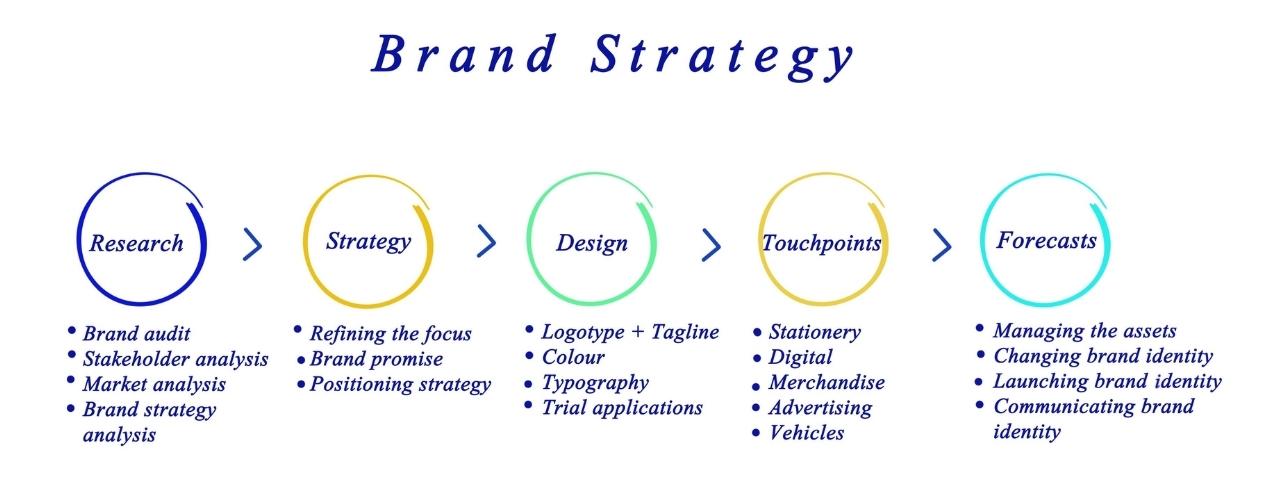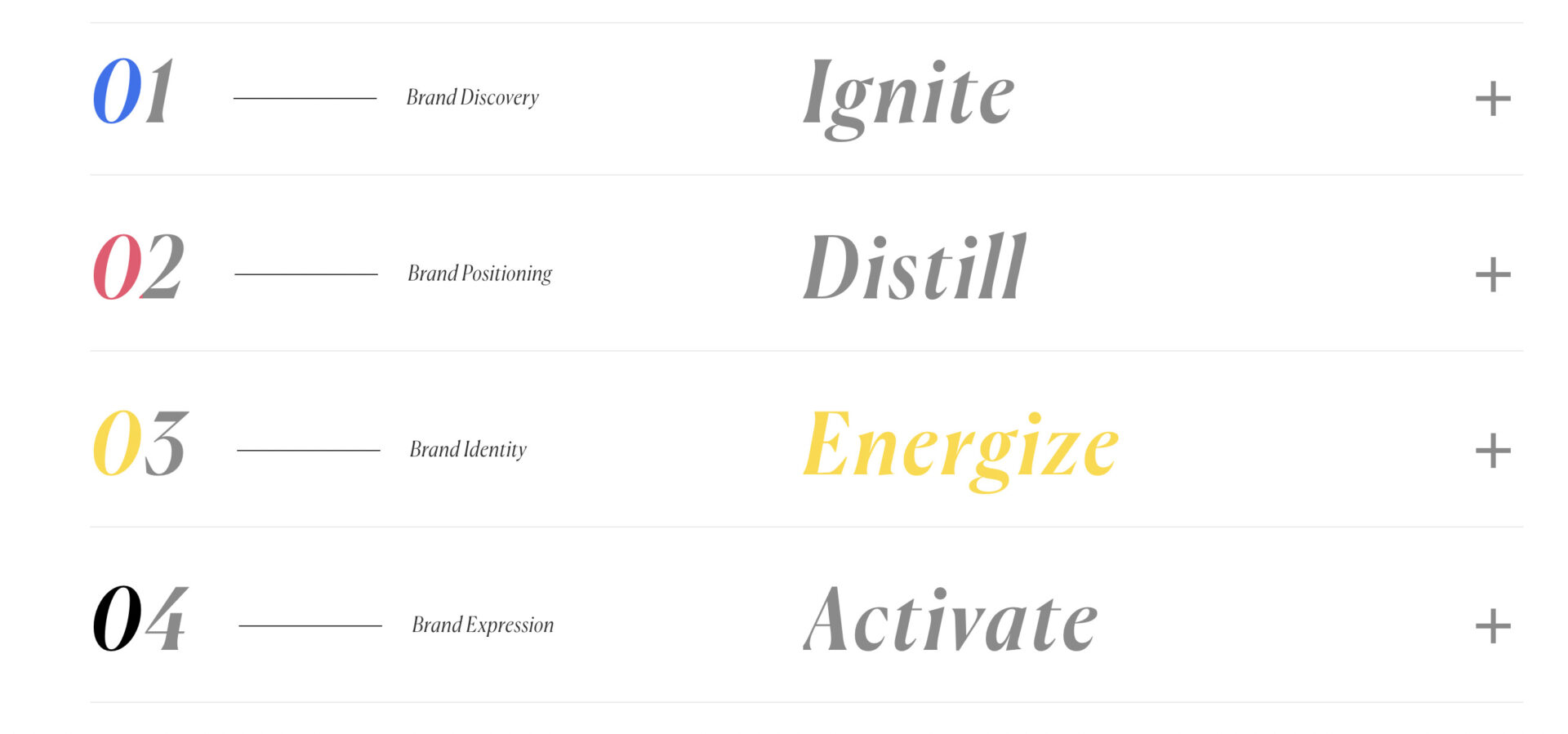
Just about everyone you meet will have some idea of what a “brand” is. But while the imagery and aesthetics tend to get the spotlight, the behind-the-scenes work that it takes to create a brand, like branding strategy, doesn’t enjoy the same level of fame.
Why?
Well, many people can’t answer, “What is a branding strategy?” Because there are many moving parts, it’s not so simple. Furthermore, they may not understand fully how having one (or not having one) can impact business in major ways.
When most people think of brands, they have a surface-level understanding. Most of what we initially know about brands comes from how we experience them, not from the work it took to get there.
A brand isn’t just a logo and a color palette. And it isn’t your taglines, merchandising, or other external facing messages or visuals.

Those things are part of your brand, and the most immediately recognizable. But you can’t just slap together a logo and choose a tagline at random. They need to resonate with your audience and be authentic to who your company really is.
Your external-facing brand elements are the tip of a very large iceberg. Beneath them, there’s a huge amount of strategic intelligence that’s necessary for support. Without this support– the brand strategy– a brand stays afloat about as well as the Titanic.
Building a brand is about engineering your customers’ experience of your company. It’s a way for your customers to know who you are and what you stand for – no matter where, when, or how they encounter your company. The branding strategy is what you need to make that possible.
Knowing the importance of a brand is important when asking, “what is a branding strategy?” With a clear brand strategy, your buyers instantly know who you are and what you stand for. This leads to increased customer loyalty and a higher lifetime value.
Branding strategy – why does it matter?

So, what is a branding strategy, and why does it matter?
First, let’s discuss some basic terms. The answer to “what is a brand?” is interlinked with the answer to “what is branding strategy?”
“A brand” in general refers to a bird’s eye view of who the business is (or wants to be) perceived by customers. It’s all-encompassing– it includes how you talk to your employees, your customers, your stakeholders, and your competitors. The brand is you.
“Brand strategy” is how you get there. Think of it like a roadmap to becoming yourself, and the lighthouse that keeps everyone clear on where you stand. Brand strategy is the first step in taking all the intangible elements– how your company makes people feel, what makes your offering unique, why you matter in the market– and turning it into clear insights that then fuel concrete actions. The brand strategy identifies the core concepts, values, and promises that will guide all actions you take to communicate your brand to customers.
Take brand examples like Coca-Cola, Apple, or Nike. When you think of these brands, you might see their logo or one of their products immediately in your mind. You might also instantly think of their tagline– “Just Do It,” or “Think Different.” You might identify a feeling– happiness, innovation, or freedom. This is all the product of a solid brand strategy.
A brand strategy lays out who you are and what you stand for. It’s the foundation on which all external messaging and visual elements are built. With a clear brand strategy, all your brand elements are aligned around the same idea.
Without a clear strategy, there is no brand. It’s all the intelligence that positions you in the market. Once your position is clear, then you can start telling people about it through visuals, messaging, and campaigns.
Asking “what is a branding strategy” is really only the very beginning of the question.
The actual work of brand strategy is asking if your brand represents who you are and who you help, care for, and dream of as a company. This means that you can’t accidentally stumble upon a winning brand. You have to craft it on purpose, whether that’s in-house or using an agency with branding services.
Our Branding Strategy Framework

Here at Flux, we intentionally craft brands using our tried-and-true brand strategy framework – the IDEA Method.
The IDEA Method uses four steps to form a strong, complete brand marketing strategy, whether a business has some idea of what they want their campaign to look like or whether they’re still asking, “what is a branding strategy, anyway?”
Depending on where a company is on its branding journey, different steps of the IDEA Method might have a different emphasis. And, of course, the same step may look very different from business to business. The flexibility of the IDEA Method is what allows companies that use our method in their branding efforts to thrive.
Let’s take a deeper look at each step of the IDEA Method – Ignite, Distill, Energize, and Activate.
Ignite

This is the most “underground” stage of a brand marketing strategy. We go deep, with a 360-degree scope– looking at your company, your customers, and your competitors. Brand strategy services should always include this stage, which is heavy on auditing, research, and internal investigation.
At Flux, we believe that it’s critical. In the Ignite phase, you’re really laying the foundation for your brand, and getting together all the raw materials that will make up the brand strategy process. Like laying the foundation for a house, the Ignite phase isn’t always the most glamorous, but it certainly builds excitement.
Rather than wondering, “what is a branding strategy,” the Ignite stage asks different questions.
- Who is your brand for?
- Why are you looking to make a change?
- Where can your brand find an edge over your competitors?
- What are you all about?
Ignite is for collecting data on your customers, stakeholders, and competition to determine where your brand stands above the rest.
Distill

From there, we move on to the Distill phase. In this phase, we take all the raw data collected in the Ignite phase and turn it into distinct strategic insights and recommendations.
The information gathered in the Ignite phase is only helpful when it’s synthesized. Otherwise, you’ll end up with an inability to turn insights into action.
Or worse, interpreting the same piece of information differently– resulting in an inconsistent brand presence.
For example, say you’re building a hotel brand.
The research in the Ignite phase has determined specific unique differentiators for your hotel– you’re boutique, you’re immersed in nature, and you’re not the most expensive option (but neither are you the cheapest). People like you for your intimate service, historic building, and proximity to fun destinations.
But how does that all come together into a cohesive idea– into a brand?
This stage of the brand strategy framework is when everything concentrates on the big idea, promises, and values that the brand is built around. We take the data from the Ignite phase and boil it down to the most basic wants and needs that your brand should fill. Then, we carefully determine how to creatively express those wants and needs in your brand’s written language and visuals.
The result is a beautiful, internal-facing document.
Now when anyone on your team asks “what is a branding strategy?” or “what is our brand strategy?”, you’ll be able to point them to a manifesto that lays out everything they need to know.
Put simply, the Distill phase gives your team all the tools they need to communicate your brand without a hitch.
Energize

Energize is when we start to really electrify your brand. It’s the part of the brand strategy framework where we start turning the spotlight on your new brand. In the Energize phase, we use the brand positioning document from the Distill phase to start building your visual identity and external messaging strategies.
It’s time to put together your brand identity, or how you look. This includes logo, color palette, stationary, and more. Your identity is the visual expression of your brand strategy.
Note that visuals come after the research and brand strategy phase, so how you look is supported by a larger framework.
In the Energize phase, we’re making visible changes that will resonate with your customers. And the power of visuals can’t be overly emphasized.
Visuals are one of the things we associate most with brands because our brains can process an image in as little as 13 milliseconds. That means that it takes 0.013 seconds for a customer to recognize a brand… or ignore it. The Energize phase crafts visuals that are striking, emotionally moving, and (most importantly) memorable.
Activate

The Activate phase closes one chapter and opens another. In the Activate phase, we’re done gathering data and compiling it into something that connects with your customers.
Now it’s time to put your brand out there.
What is a branding strategy if no one sees it? The Activate phase ensures your brand gets seen by your ideal audience. In this phase, we get your new brand out in the world– creating content, campaigns, events, and more.
The internal document we put together in the Distill phase and the visuals we created in the Energize phase come together to create stunning, seamless customer interaction. Your customers can see you anywhere and know exactly who you are and what you stand for.
Your potential customers might catch a glimpse of your logo driving by, see a targeted ad on social media, or visit you during an event. No matter how they find you, they are having the same experience– it’s all an extension of the larger brand strategy. They are able to form a connection with you because they know what you’re all about.
That sense of trust is the result of all the hard work in the last three stages of the brand strategy framework.
Activate is the stage where you get to put your brand out into the world. The success of this effort is largely based on how tight the strategy is. Without a clear strategic direction, you’re throwing spaghetti at the wall.
With a solid brand strategy, your campaigns can be laser-focused and crystal clear– so you can build recognition, loyalty, and equity.
What’s the goal of a brand marketing strategy?

If you’re familiar with the marketing world, you’re probably used to setting highly-measurable goals. Maybe you want to generate $100,000 in new business using paid ads. Perhaps you want to increase the re-purchasing rate by 20% using email newsletters.
Everything has a number tied to it.
This is one of the biggest differences between product marketing vs. brand marketing.
In brand marketing, you aren’t measuring something tangible, like 1,000 products sold by the end of the month. You’re measuring something intangible – the way your employees and customers feel about your company.
That isn’t to say that it’s impossible to measure the success of a brand marketing strategy. You’ll just use different metrics.
You’re trying to measure feeling, and that may show up in an immediate increase in sales, but keeping your eyes peeled can show all kinds of other success.
How does a branding strategy affect your customers? They’ll be seeing your company with new eyes.
With a successful brand strategy, they’ll see how their values align with yours. They’ll experience your brand DNA. They’ll want to stick with you for reasons beyond the product or service you’re selling. And doing business with you won’t be just a transaction– it will be an emotional relationship that reinforces an idea they have about themselves.
And what is a branding strategy in the eyes of your employees?
They’ll also be seeing your company with fresh eyes. Your employees will get a clearer picture of the purpose and vision. Their alignment with the company’s values, ideas, and goals will elevate their work. They won’t be doing “just a job” anymore. They’ll be working for something that they can believe in.
Showing your spirit
Ultimately, a brand shows your company’s spirit. This is why it’s so hard to pin down… and so important that you do so.
Humans are emotional beings. They make decisions based on what feels right and what resonates. Therefore, you need to leverage strong emotional branding. When you have a strong brand, you elevate the experience for everyone.
Your employees aren’t just punching in and out, they’re contributing to a greater whole.
Your customers aren’t just buying goods and services, they’re buying into a bigger emotional concept.
In conclusion, what is a branding strategy, then?
It’s the job of your brand strategy to figure out what that concept is. Then, a solid brand strategy will put structure all the necessary visual and written communication tactics to make that big idea clear to everyone.
Think of building your brand as you would building a house. Before you can have a beautiful house to entertain friends, you need a blueprint. You need a foundation. Without that, the house will fall. Brand strategy is the big idea and the plan to bring it to the world.
But you don’t have to do it alone. Flux is a top branding agency in Los Angeles – and we help people all over the country. Reach out to see how the IDEA framework can help your business and feel the difference a solid brand strategy can make.